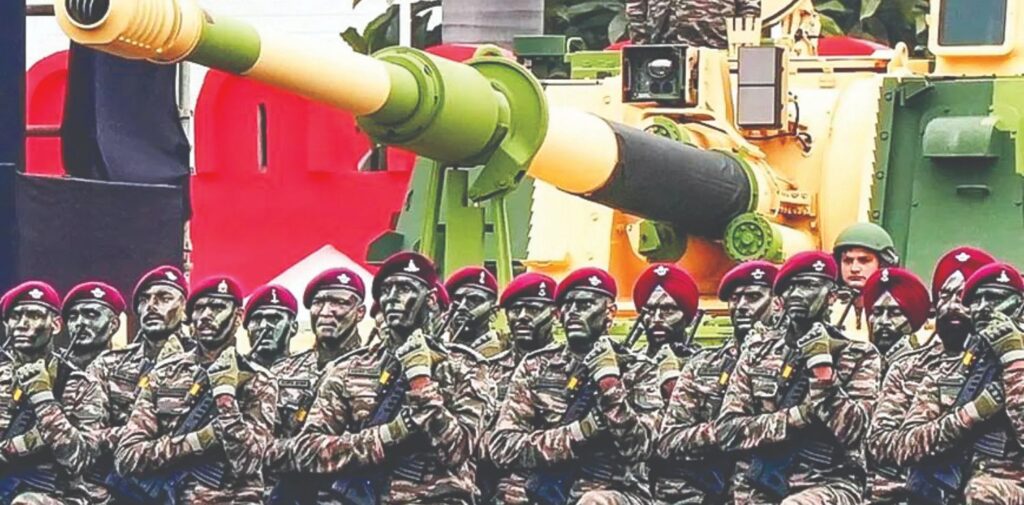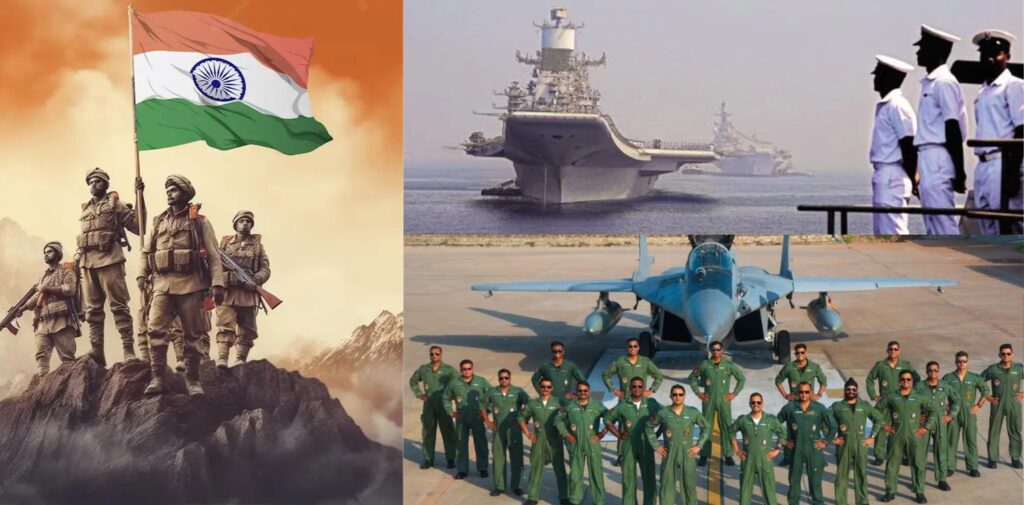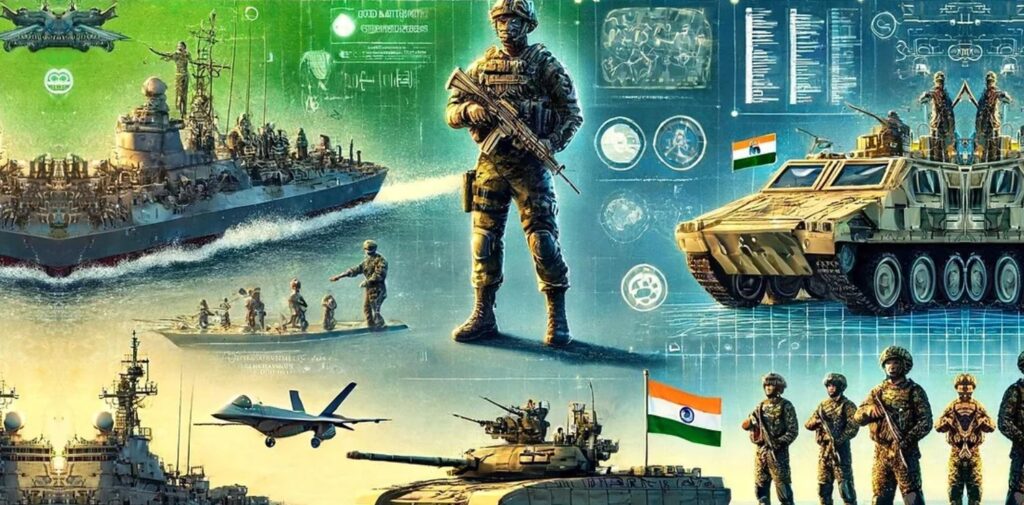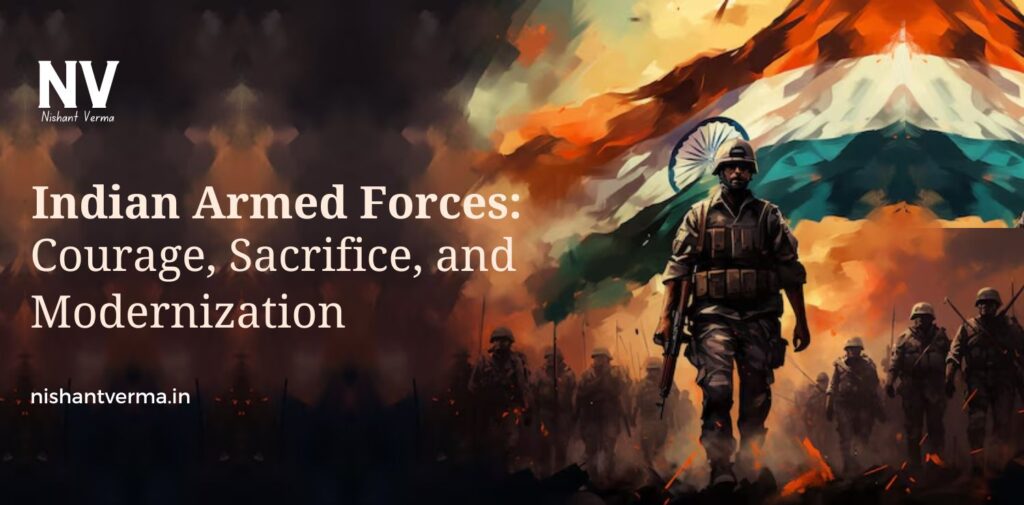India’s Armed Forces stand as a symbol of strength, discipline, and honour. With a rich history of courage and sacrifice, the Indian military has consistently demonstrated its unwavering commitment to protecting the nation and ensuring its security. Over the years, the Indian Armed Forces have not only gained a reputation for bravery but have also undergone significant modernization to meet the challenges of the 21st century. This article explores the courage, sacrifice, and modernization of the Indian Armed Forces and celebrates their invaluable contribution to the nation’s security.

Legacy of Courage and Sacrifice
The Indian Armed Forces have a long and proud history, stretching back to ancient times. From the great warriors of the Maurya and Gupta empires to the brave soldiers who fought during India’s struggle for independence, courage and sacrifice have been at the heart of India’s military tradition. The modern Indian Armed Forces continue this legacy, with countless acts of bravery and selflessness displayed by soldiers, sailors, and airmen.
The Indian military has been involved in several wars and conflicts, defending the country from external threats and maintaining peace in volatile regions. From the 1947-48 war with Pakistan over Kashmir to the 1962 war with China, and the 1971 Indo-Pak war, Indian soldiers have fought with incredible bravery, often in challenging and difficult circumstances. Many soldiers gave their lives in these battles, showing the true meaning of sacrifice. The Kargil War of 1999, fought against Pakistan, was another example of exceptional courage. Indian soldiers, despite being in difficult terrain and facing extreme weather, displayed immense determination and patriotism. The victory in Kargil remains one of the proudest moments in India’s military history.
The bravery of the Indian Armed Forces is not limited to wars alone. Every day, soldiers risk their lives to ensure the safety of India’s borders, even in times of peace. Whether it is guarding the cold, inhospitable terrains of the Siachen Glacier or patrolling the hot and dry deserts of Rajasthan, the men and women of the Indian Armed Forces are always ready to face any challenge head-on. The sacrifices of these soldiers, who often spend long months away from their families and homes, are beyond measure. They are the unsung heroes who ensure that the nation sleeps in peace, knowing their borders are secure.

Structure of the Indian Armed Forces
The Indian Armed Forces are one of the largest and most powerful in the world, consisting of three main branches: the Indian Army, the Indian Navy, and the Indian Air Force. Each branch plays a crucial role in safeguarding the country’s interests and maintaining national security.
- The Indian Army: The Indian Army is the backbone of India’s defence. With its diverse range of infantry, artillery, and armoured divisions, the army is always prepared to handle any threat. The Indian Army is known for its strong ethos, discipline, and resilience. Its soldiers are trained to fight in every type of terrain and climate, from the freezing heights of the Himalayas to the scorching heat of the Thar Desert.
- The Indian Navy: India’s geographical location, surrounded by oceans on three sides, makes the Indian Navy a key player in ensuring national security. The Navy is responsible for safeguarding India’s maritime borders, maintaining control over vital shipping routes, and protecting India’s interests in the Indian Ocean. The Navy operates a powerful fleet of warships, submarines, and aircraft. It plays an essential role in disaster relief operations and humanitarian missions, both within India and internationally.
- The Indian Air Force: The Indian Air Force (IAF) is one of the most advanced and capable air forces in the world. It operates a wide array of fighter jets, transport aircraft, and helicopters, and plays a key role in air defence and aerial warfare. The IAF’s ability to respond quickly to any aerial threat is unmatched, and its skilled pilots have shown great courage and precision in operations. The Air Force is also a critical part of India’s defence strategy, with the ability to conduct both defensive and offensive operations.
These three branches work in close coordination, ensuring that India’s defence needs are met in a comprehensive and effective manner.
Modernization of the Indian Armed Forces
In the face of evolving global threats and changing technological landscapes, the Indian Armed Forces have embraced modernization to stay ahead. India’s military has undergone extensive reforms and upgrades over the past few decades, incorporating the latest technology and innovations into its defence systems. This modernization has made the Indian Armed Forces more efficient, effective, and capable of dealing with modern-day challenges.
- Technology Integration: The Indian military has increasingly incorporated advanced technology into its operations. The use of cutting-edge weapons, surveillance systems, and communication equipment has enhanced the capabilities of the armed forces. From precision-guided missiles to advanced fighter jets like the Sukhoi Su-30MKI, these Forces are equipped with state-of-the-art weaponry that ensures they are prepared for any eventuality. The Indian Army’s acquisition of tanks like the Arjun and the artillery systems like the M777 howitzer strengthens its combat capabilities.
- Cyber Warfare and Space Technology: In today’s world, the battlefield is not limited to land, sea, and air. Cyber warfare has become an essential part of national defence, and India has invested heavily in building its cyber capabilities. The Indian Armed Forces are constantly upgrading their cyber defence strategies to protect the country’s critical infrastructure from cyber-attacks. Similarly, India’s advancements in space technology, including the development of satellite systems, have significantly bolstered the military’s surveillance and communication capabilities.
- Indigenous Defense Production: India has made great strides in developing its own defence technologies and weapons. The government’s push for “Atmanirbhar Bharat” (self-reliant India) has resulted in the creation of an Indigenous defence industry capable of producing advanced weaponry and equipment. The Indian Armed Forces now rely more on domestically manufactured weapons, including the Tejas fighter jet, the INS Vikrant aircraft carrier, and the Akash missile defence system. This reduces India’s dependence on foreign arms suppliers and boosts the country’s defence self-sufficiency.
- Improved Training and Special Forces: The training of Indian Armed Forces personnel has become more advanced, with the integration of new techniques and combat strategies. The Special Forces, including the Para Commandos and the National Security Guard (NSG), are among the best in the world, trained to tackle high-risk operations such as counter-terrorism, hostage rescue, and covert missions. These elite forces operate with precision, skill, and courage, ensuring that India is prepared for any unconventional threat.

Role of the Indian Armed Forces in Global Peacekeeping
India’s Armed Forces are not only tasked with defending the nation’s borders but also play an important role in global peacekeeping efforts. India has contributed significantly to United Nations peacekeeping missions, sending its soldiers to conflict zones around the world. Indian soldiers are highly regarded for their professionalism, discipline, and humanitarian approach in peacekeeping operations. From Africa to the Middle East, Indian peacekeepers have helped stabilize conflict zones and protect civilians from violence.
India’s commitment to peace and security is also reflected in its participation in international defence collaborations, military exercises, and strategic partnerships with other countries. These collaborations enhance India’s defence capabilities while promoting global peace and stability.
Conclusion
The Indian Armed Forces embody the values of courage, sacrifice, and patriotism. They are the guardians of India’s sovereignty, ensuring that the nation remains safe and secure in an unpredictable world. Their modernization efforts and adaptability to new technologies ensure that they remain at the forefront of global defence. The courage and sacrifices of the men and women who serve in the Indian military are unmatched, and they inspire pride and respect in the hearts of every Indian.
As India continues to grow as a global power, the Indian Armed Forces will remain an integral part of the nation’s strength, both on the battlefield and on the world stage. Their commitment to defending the country and maintaining peace at home and abroad sets a remarkable example of service and duty. The Indian Armed Forces truly represent the spirit of a strong, united, and resilient nation.




